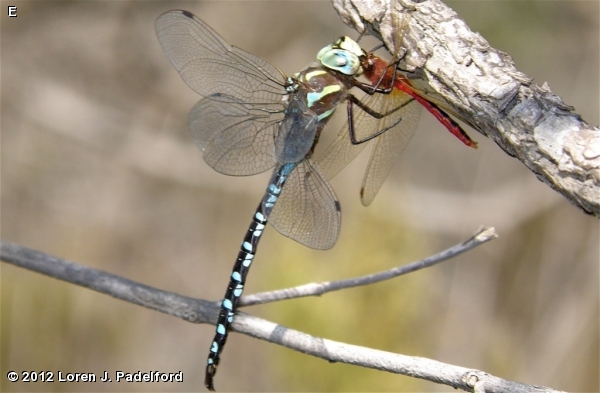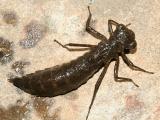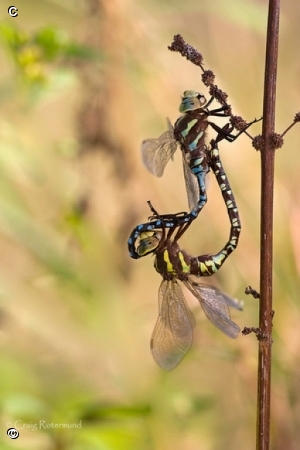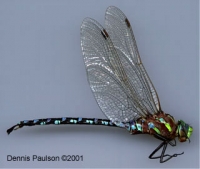Sometimes we are privy to a glimpse of what a dragonfly's life may be. Perhaps you have been fortunate enough to have marveled at the Dragonhunter's acrobatic flight or to have watched a nymph emerge from its exuvia. Last week, a group of us were startled to witness a teneral Green Darner devour the head from an admirable adversary, the Lance-tipped Darner. The beauty? The gorgeous defeated was documented in Riverside Park for the first time that day. The brutality? He was eaten by a fellow darner, cannibalized alive, while the nerves of his detached body caused his legs to repeatedly twitch and quiver. The justice? While the Lance-tipped Darner was the loser in this battle, he could just as likely have been the winner.The awesomeness? Sheer power and barbaric lifestyles are things that we have historically both admired and feared. Medieval knights. Roman warriors. The dinosaurs. The dragonfly has lived hard and outlasted them all.
Odonates (Dragonflies and Damselflies) are powerful fliers, maneuvering in all directions and reaching speeds of 36 mph. They hunt, mate and even lay eggs while on the fly. They are fierce hunters, feasting on everything from soft-bodies insects to other odonates.
(Dragonflies and Damselflies) are powerful fliers, maneuvering in all directions and reaching speeds of 36 mph. They hunt, mate and even lay eggs while on the fly. They are fierce hunters, feasting on everything from soft-bodies insects to other odonates.
Lance-tipped Darners (Aeshna constricta) sport flashy metallic green stripes on their thorax and bright blue spots on their abdomen. The Lance-tipped Darner is native to Wisconsin and is commonly found across the state in marshy ponds, slow streams and temporary ponds. They are part of the group of dragonflies known as the Mosaic Darners (or Blue Darners) and are large, strong-flying dragonflies. They typically fly in Wisconsin from July through October and often spend August in fields far away from their breeding grounds. Lance-tips have the ability to physiologically regulate their body temperature and can be found flying late in the season after many other dragonfly species have disappeared. As adults, they prefer to eat mosquitoes, moths and mayflies, but as nymphs, they prefer to eat mosquito and fly larvae, small fish and even tadpoles!
 The dragonfly starts its life as an egg, usually deposited in the fall in wet plant stems. After hatching, the larval form (or nymphs) grows in size underwater, shedding their skin 10-12 times. When the dragonfly is ready for final emergence (an average of two years), it will crawl out of the water, attach itself to a secure spot above the water's surface and molt out of its final larval skin. It will stay in this spot for at least a half hour, pumping hemolymph into its wings to enlarge and straighten them. As soon as the wings dry, the young teneral will be able to weakly fly and will then spend the next three weeks of its life gaining strength, producing adult coloration and becoming sexually mature.
The dragonfly starts its life as an egg, usually deposited in the fall in wet plant stems. After hatching, the larval form (or nymphs) grows in size underwater, shedding their skin 10-12 times. When the dragonfly is ready for final emergence (an average of two years), it will crawl out of the water, attach itself to a secure spot above the water's surface and molt out of its final larval skin. It will stay in this spot for at least a half hour, pumping hemolymph into its wings to enlarge and straighten them. As soon as the wings dry, the young teneral will be able to weakly fly and will then spend the next three weeks of its life gaining strength, producing adult coloration and becoming sexually mature.
 Dragonfly adults only live about a month. When a male has found a female, he will grab the female thorax with his hind legs and arch his back to grab her head with specialized claspers (creating a "tandem"). The female then swings her abdomen around grabbing the male's secondary genitalia and creates "a wheel" while mating. This method is unique in the insect world (the Lance-tipped Darner is an exception and does not hold the female in tandem while she oviposits). Males are very territorial and will fight to the death to protect a female with which he has procreated. The female will lay her eggs in plants and vegetation several feet above the water line rather than in submerged vegetation.
Dragonfly adults only live about a month. When a male has found a female, he will grab the female thorax with his hind legs and arch his back to grab her head with specialized claspers (creating a "tandem"). The female then swings her abdomen around grabbing the male's secondary genitalia and creates "a wheel" while mating. This method is unique in the insect world (the Lance-tipped Darner is an exception and does not hold the female in tandem while she oviposits). Males are very territorial and will fight to the death to protect a female with which he has procreated. The female will lay her eggs in plants and vegetation several feet above the water line rather than in submerged vegetation.
Fun Facts
- It's not just monarchs! There are about a dozen dragonflies that migrate in the United States, the most well-known being the Common Green Darner. Their migration is a one-way journey leaving in the early spring to head north or leaving in the fall to head south.
- Speaking of migration... The Globe Skimmer has the longest known migration of any dragonfly species. Their migration travels from Maldives to Africa and back again clocking in at nearly 11,000 miles!
- Dinosaurs are mere babies compared to dragonflies. Dragonflies date back in the fossil record over 300 million years ago some with wing-spans of up to two feet! The first dinosaurs date back 230 million years.
- The Jetsons have nothing on dragonflies. Dragonfly nymphs use jet propulsion to locomote by shooting water out of the end of their abdomens.
- Why can't we all just get along? Although the Lance-tipped Darner is relatively common in Wisconsin, the habitats they fare best in lack sunfishes and certain bass species in their waters.
- Two of a kind?! Lance-tipped Darners commonly flock over dirts roads with another darner species, the Variable Darner (Aeshna interrupta).
*This article was written using Kurt Mead's Dragonflies of the North Woods, Dennis Paulson's Dragonflies and Damselflies of the East and the wiatri.net and imnh.isu.edu websites.





